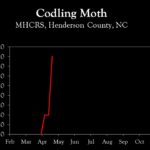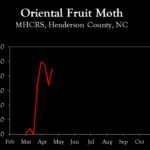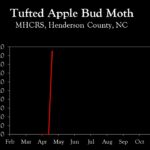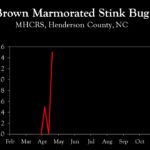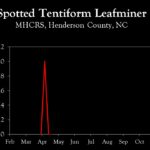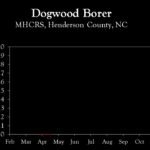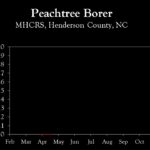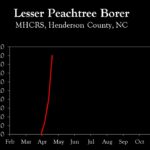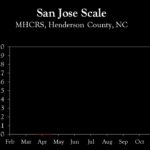WNC Orchard Insect Pest Populations – April 26, 2023
go.ncsu.edu/readext?932446
en Español / em Português
El inglés es el idioma de control de esta página. En la medida en que haya algún conflicto entre la traducción al inglés y la traducción, el inglés prevalece.
Al hacer clic en el enlace de traducción se activa un servicio de traducción gratuito para convertir la página al español. Al igual que con cualquier traducción por Internet, la conversión no es sensible al contexto y puede que no traduzca el texto en su significado original. NC State Extension no garantiza la exactitud del texto traducido. Por favor, tenga en cuenta que algunas aplicaciones y/o servicios pueden no funcionar como se espera cuando se traducen.
Português
Inglês é o idioma de controle desta página. Na medida que haja algum conflito entre o texto original em Inglês e a tradução, o Inglês prevalece.
Ao clicar no link de tradução, um serviço gratuito de tradução será ativado para converter a página para o Português. Como em qualquer tradução pela internet, a conversão não é sensivel ao contexto e pode não ocorrer a tradução para o significado orginal. O serviço de Extensão da Carolina do Norte (NC State Extension) não garante a exatidão do texto traduzido. Por favor, observe que algumas funções ou serviços podem não funcionar como esperado após a tradução.
English
English is the controlling language of this page. To the extent there is any conflict between the English text and the translation, English controls.
Clicking on the translation link activates a free translation service to convert the page to Spanish. As with any Internet translation, the conversion is not context-sensitive and may not translate the text to its original meaning. NC State Extension does not guarantee the accuracy of the translated text. Please note that some applications and/or services may not function as expected when translated.
Collapse ▲ Sorry about starting the pest updates a little late this year, but it’s taken us a while to get our footing after falling behind with the earliness of the season. Bloom is essentially complete throughout most of the region, and most orchards are between petal fall and first cover. That means the key pests at this time are plum curculio, oriental fruit moth (OFM), San Jose scale, and codling moth (coming along shortly).
Sorry about starting the pest updates a little late this year, but it’s taken us a while to get our footing after falling behind with the earliness of the season. Bloom is essentially complete throughout most of the region, and most orchards are between petal fall and first cover. That means the key pests at this time are plum curculio, oriental fruit moth (OFM), San Jose scale, and codling moth (coming along shortly).
Except for the highest elevation orchards, hopefully a petal fall insecticide has been applied, targeting plum curculio and OFM. In those orchards where a prebloom spray for rosy apple aphid was not made, something for this insect should also be considered. There are several insecticides or combinations of products that can achieve this goal. Voliam Flexi (premix containing chlorantraniliprole and thiamethoxam) is the only product that will control all three insects, while Avaunt, Imidan and Verdepryn will control plum curculio and OFM, and Belay and Actara will control plum curculio and rosy apple aphid.
If an insecticide for San Jose scale was not applied before bloom, the window for control is still open until First Cover. Insecticides of choice include Esteem, Centaur or Assail. Esteem and Centaur are the highest rated products for SJS, but Assail also has good activity. It serves as a good choice at First Cover as it will also provide control of early emerging codling moth and supplement rosy apple aphid control.
The cooler weather extending into the middle of next week will slow codling moth activity. Biofix for codling moth in Henderson County was 7 April, and is usually about a week earlier at lower elevations in Cleveland and Burke Counties. With only 130 DD accumulated as of 25 April, we are likely 7 to 10 days or so before egg hatch begins in most orchards. However, this may be further delayed if evening temperatures remain low, because moth activity is suppressed when temperatures are less than 62°F during dusk and shortly after.
Learn more about southeastern apple insect pests at the Apple Insect Management page.
2023 Average Weekly Trap Captures
| HENDERSON COUNTY | |||
| Insects per trap | |||
| Apr 11 | Apr 17 | Apr 24 | |
| Codling moth | 2.0 | 2.0 | 8.0 |
| Oriental fruit moth | 95.5 | 67.5 | 89.5 |
| Tufted apple bud moth | 0.0 | 0.0 | 19.0 |
| Redbanded leafroller | 2.0 | 4.0 | 4.0 |
| Obliquebanded leafroller | – | – | – |
| Lesser appleworm | – | – | – |
| Apple maggot (abandoned and research orchards) | – | – | – |
| Brown marmorated stink bug (commercial) | – | – | – |
| Brown marmorated stink bug (unsprayed) | 0.5 | 0.0 | 1.5 |
| Spotted tentiform leafminer | 1.0 | 0.0 | 0.0 |
| Dogwood borer | 0.0 | 0.0 | 0.0 |
| Peachtree borer | 0.0 | 0.0 | 0.0 |
| Lesser peachtree borer | 7.0 | 20.0 | 45.0 |
| San Jose scale | 0.0 | 0.0 | 0.0 |
*Note that these averages illustrate only the timing of insect emergence and fluctuations in populations, and are not representative of population levels in any given orchard. The only way to have an accurate assessment of an individual orchard’s populations is to set up traps in that orchard.
2023 Accumulated Degree Days
| HENDERSON COUNTY | ||||
| Apr 11 | Apr 17 | Apr 24 | ||
| Codling moth (Biofix: April 7) | 19 | 72 | 130 | |
| Oriental fruit moth (Biofix: March 24) | 201 | 285 | 366 | |
| Tufted apple bud moth (Biofix: April 21) | – | – | 13 | |



